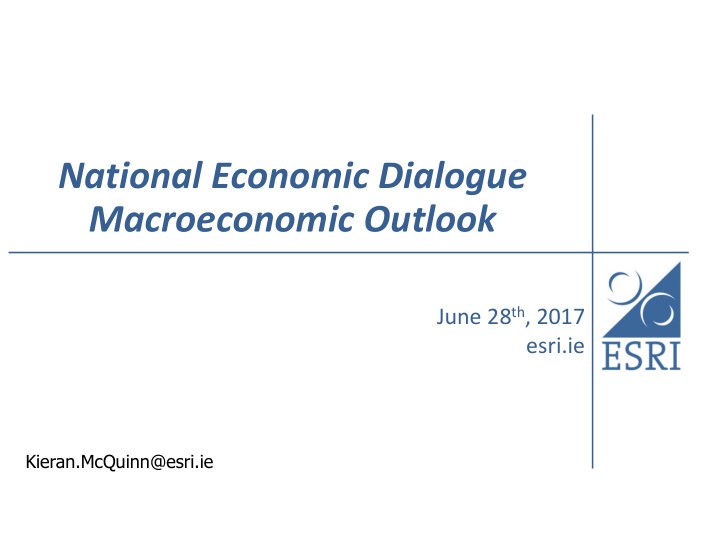



National Economic Dialogue Macroeconomic Outlook June 28 th , 2017 esri.ie Kieran.McQuinn@esri.ie
Outline Forecasts Domestic and External Environment Monetary and Financial Conditions Housing Market Public Finances and Brexit Conclusions and General Assessment
Irish economy: boom, bust and boom? Recession and Export lead growth Domestic lead Recovery growth 14 12 10 8 6 4 2 0 1989 1993 1997 2001 2005 2009 2013 2017 -2 -4 -6 -8 GDP , % change, volume
Economic growth to continue in 2017 and 2018 Output Real GDP to grow by 3.8% in 2017 and by 3.6% in 2018 Employment (2018) Numbers employed to average of 2.134 million Unemployment rate to average 5.4% Public finances Tax revenues lower than expected 2017: -0.5%, 2018: -0.3%
Forecast summary Real Annual Growth % 2015 2016 2017 2018 Consumption 4.5 3.0 3.1 3.0 Govt. Expenditure 1.2 5.3 2.5 2.6 Investment 32.7 45.5 9.5 8.7 Exports 34.4 2.4 5.9 5.6 Imports 21.7 10.3 7.6 7.7 Gross Domestic Product (GDP) 26.3 5.2 3.8 3.6 Gross National Product (GNP) 18.7 8.9 3.5 3.3
Labour market Unemployment rate 6.4 per cent in May Employment growth: 3.3 per cent in 2017 and 2.3 per cent in 2018 Unemployment rate 5.3 per cent by end of 2018 Strong 2017 Q1 growth in Construction and ICT sectors
Investment Volatility in components such as Intangibles and transport equipment Core Investment growing strongly Building and construction Dwellings 27.6 per cent in 2016 Expected housing completions 18,500 in 2017 and 23,500 in 2018
External environment Export growth of 5.9% and 5.6% in 2017-18 Imports expected to outpace exports Net exports negative contribution Brexit still a source of great uncertainty Large Forecast range for UK Soft Brexit more likely? Despite international uncertainty Overall trade outlook positive
Investment and consumption driving growth 30.0 25.0 20.0 15.0 10.0 5.0 0.0 -5.0 -10.0 2011 2012 2013 2014 2015 2016 2017 2018 Consumption Government Spending Net Exports Investment
Monetary and financial conditions Normalisation of activity in banking sector Pace of deleveraging slowing Fall in non performing loans Credit growing New lending to SME’s Mortgage credit Low base Careful monitoring required
Credit to SME’s trending up (4 quarter rolling average) 1400 1200 Other 1000 Business services including ICT and Finance Hotels and restaurants 800 Wholesale and retail 600 Construction and real estate 400 Manufacturing, transport 200 and utilities Primary industries 0 Dec-10 Apr-11 Aug-11 Dec-11 Apr-12 Aug-12 Dec-12 Apr-13 Aug-13 Dec-13 Apr-14 Aug-14 Dec-14 Apr-15 Aug-15 Dec-15 Apr-16 Aug-16 Dec-16
Annual growth of new mortgage drawdowns (%) 1.00 Number of Mortgages 0.80 Value of Drawdowns 0.60 0.40 0.20 0.00 -0.20 -0.40 -0.60 -0.80 Q1 Q3 Q1 Q3 Q1 Q3 Q1 Q3 Q1 Q3 Q1 Q3 Q1 Q3 Q1 Q3 Q1 Q3 Q1 Q3 Q1 Q3 Q1 2006 2007 2008 2009 2010 2011 2012 2013 2014 2015 2016 2017
Housing market Increasingly driving domestic growth Mortgage drawdowns up 40% YoY (low base) Construction employment Continued upward pressure on Prices up 10.5% April YoY Rents up 8.6 per cent nationally Revised estimates of structural demand 30,000 – 35,000 units required 18,500 in 2017?
Assessment of the public finances Strong tax receipts in 2016. Tax revenue weaker than expected in 2017 Corporation tax, Income tax growth, excise. General Government deficit/surplus (%GDP) -0.5 in 2017 -0.3 in 2018 Deficit higher than previously expected.
Annual changes in major tax sub-components (%) for the period January - May 120.0 100.0 80.0 60.0 40.0 20.0 0.0 -20.0 -40.0 -60.0 2014 2015 2016 2017 Excise Duty Stamps Income Tax Corporation Tax Valued Added Tax Total
Alternative debt to GDP 130.0 120.0 110.0 100.0 90.0 80.0 70.0 60.0 2013 2014 2015 2016 2017 2018 Adjusted GDP GDP
Impact of Brexit on potential output “Hard” Brexit (WTO) reduces economic activity in the medium term Loss of GDP after 10 years: 3.2% in the UK (NIESR, 2016) and 3.8% in Ireland (ESRI, 2016) with respect to baseline Lower activity affects potential output Emphasis on the traded sector Higher unemployment reduces hours Lower investment hurts capital accumulation
Potential output loss, sectoral disaggregation 0 -0.5 -1 -1.5 -2 -2.5 -3 -3.5 t t+4 t+8 t+12 t+16 t+20 t+24 t+28 t+32 t+36 t+40 Traded sector Non-traded sector Government sector Potential output
Implications for fiscal space Expenditure benchmark Spending can grow at reference rate potential Hard Brexit Reduces potential output and Reference rate Ultimately this means Reduced fiscal space over the medium-term Cumulative impact of € 600 million after 3 years
General assessment International environment uncertain On balance positive Credit growth Sustainable but requires monitoring Domestic sources of growth remain robust Construction + Consumers Caution on the public finances: Weak growth in taxation revenue Possible impact of hard Brexit
Thank You
ESRI/RTB rent index 110 Q3 2007=100 100 90 80 70 Q3 Q1 Q3 Q1 Q3 Q1 Q3 Q1 Q3 Q1 Q3 Q1 Q3 Q1 Q3 Q1 Q3 Q1 Q3 Q1 2007 2008 2009 2010 2011 2012 2013 2014 2015 2016 2017 National National Houses National Apts
External environment Euro Area United States United Kingdom 4 4 4 3 3 3 2 2 2 1 1 1 0 0 0 -1 -1 -1 -2 -2 -2 2012 2013 2014 2015 2016 2017 2018 2012201320142015201620172018 2012 2013 2014 2015 2016 2017 2018
Irish economy showing strong growth 30.0 25.0 20.0 15.0 10.0 5.0 0.0 -5.0 -10.0 2009 2010 2011 2012 2013 2014 2015 2016 2017 2018 GDP GNP
Housing supply trends 1800 1600 1400 1200 1000 800 600 400 200 0 2015 2016 2017
Recommend
More recommend